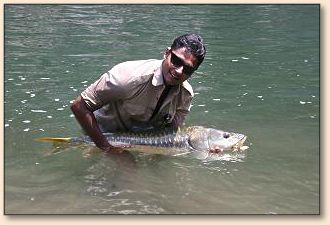The rivers of the Indian Himalayas offer the remoteness
and the promise of some of the wildest, most untapped
fishing and fly-fishing waters anywhere. Out of the
several rivers, that drain the Himalayan ranges, Mahseer
are to be found in almost all of them, some more apt
for the trophy Mahseer fishing, and the others for
fly-fishing.
As the promoted and the unsurpassed techniques to fish
for these legendry game fish in the Himalayas are
fly-fishing and spinning, yet all options need to be
kept open and a fishing trip needs to have the
flexibility of changing locations and techniques according
to the conditions on a river. Some of the best Mahseer
fishing is to be had in the remotest rivers of the
Himalayas, as they are unspoiled and undammed. The
fishing techniques used here are quite similar to
Salmon fishing, though the rivers will often run larger.
Undeniably, one of the most effective ways to fish
these vast glacial rivers is by rafting down on them,
with all supplies for a multi-day trip on the rafts
and by floating down over a period of time, accessing
the remotest spots with much ease and without getting
into the even more complicated logistics and time
wastage of trekking.
The Diversity and Possibilities
The Himalayas are too vast an area to pass off a judgment
on with regards to the fishing possibilities, and though
the primary game fishing remains to be the Mahseer, there
are plenty of rivers where there are rainbow and brown
trout. The Giant game fish - Goonch - is another attraction
for some.
The Himalayan states with some of the most promising fishing
and fly-fishing waters are Assam, Arunachal Pradesh, Himachal
Pradesh, Jammu and Kashmir, and Uttaranchal. Some of the good
rivers for Mahseer fishing vary vastly in features too, as
they could be both spring-fed and glacial.
Spring-fed rivers are slightly more predictable, and run
clear for most part of the year - the window you could
fish for Mahseer in them is slightly larger. A lot of
these larger spring fed rivers could be fished at night
too and the results are startling.
Glacial rivers however are fished differently and the
chances of taking larger fish are higher. Some of the
finest Mahseer Rivers are glacial. These include the
Ganges, the Mahakali, the Siang, the Yammuna, the Beas,
the Subhansiri, and many others which are inaccessible.
Many large Mahseer will stay put in glacial rivers for
most part of the year and then migrate to the tributaries
and sub-tributaries on getting an indication, though that
is perhaps, because of the gigantic size of some of the
glacial rivers, which offer refuge to a majority of them.
Large Mahseer reside in the deeper pools and rapids of
spring-fed rivers too.
When fishing for these fish a variety of options need
to be open keeping in consideration the wide variety of
feeding tendencies of the Mahseer - fly-fishing is the
recent success story, despite the fact that it has been
practiced since decades thought the rivers of India - with
newer more off-the-cuff fishing techniques and improvised
flies there have been better results. Fly-fishing for Mahseer
is a growing trend as there are newer possibilities vacant,
and as it has always been, perhaps the most gratifying of
all techniques to take a Mahseer.
Out of all I find fly-fishing to be the most sundry and
exciting of all, for, if the fish are not feeding on
minnows - lures go wrong. I feel the blend of fly-fishing
and spinning, both brilliant game-fishing techniques is
a terrific one for fishing the Himalayan Rivers.
The Mighty Migration
The Himalayan Mahseer carry out an annual migration to
their favourite spawning grounds upriver, once, twice
or sometimes even more frequently, though the major
migration happens in the peak of the monsoon season,
July and August, when due to the heavy monsoon and the
snow melt, the rivers are in full flow. Mahseer swim
up to the tributaries and the sub-tributaries to deposit
their spawn. The Himalayan Mahseer dispatches their
spawn in batches and not all in one go.
Shortly after the monsoon these rivers are at their prime
to fish, and the timing varies by a few weeks from river
to river. The fish essentially are returning from the
tributaries of the main rivers and the reciting water
level gives them an indication to return back to their
habitat, the main river. As the fish return to the main
river they are seem to have a rampant appetite for almost
every thing. The reciting water levels show clearly the
marks the fish make on the rocks to lick the algae clean
off the rock and of course fish and even flies are taken
rather promptly during this time. This time of the years
is principle for large Himalayan Mahseer and all fish are
likely to be out of their regular hangout areas and
transiting.
The next best time is the spring season, February middle
though the early part of May. Again variations occur in
the fishing from river to river and some even could be
fished till the end of May. The conditions during this
period are rather settled and in the case of the glacial
river there could be a movement amongst some fish as the
snowmelt descends, towards the middle-end of the April.
Snowmelt waters are great for the fishing too, specially
at the confluences the fly-fishing gets even better.
The rivers of North Eastern India have different conditions
to the northern rivers and are situated in a rather lush
landscape - the rain forests in the base of the Himalayas.
This area still features some of the finest and most
untouched rivers. The rivers here generally come to life
with Mahseer only towards the end of October as the monsoons
here are rather stretched and finish late and for the weather
to settle down and the conditions in this impenetrable bush
to become favourable, November is a perfect month. February
and March are also favourable months for the fishing here.
The Himalayan Legends (barbus tor putitora)
These Mahseer attain sizes of as much as 85 lbs, and a 20
to 40 lb fish is often had on spinning. Often the figures
are not found to be impressive, at least for the anglers
who get into a comparison of the Himalayan Mahseer with
the Humpbacked Mahseer found in the Cauvery river system
in the south of India, which of course do not take to
lures and flies as fondly as the Himalayan monsters do.

The two fish are quite different in physical features
as well as other aspects and are to be found in rather
different terrain and landscape. The Humpbacked Mahseer,
the so called larger Mahseer limits it self to only two
river system of in southern India, the Cauvery River,
which is the hub of commercial fishing trips in India,
and the other - the Kabbini now is more or less extinct,
following the construction of a dam on the prime fishing
section some years back.
The waters of the Cauvery River are only limited and
quite heavily fished. The river has amazing
accessibility - which perhaps is also another reason
for it being so well frequented by anglers.
History
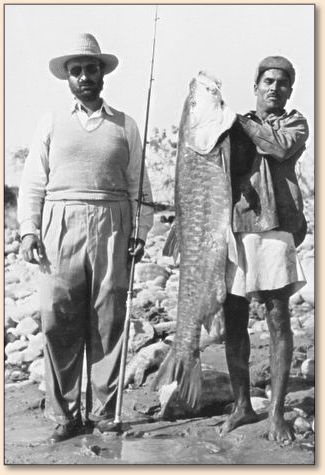 Some of the preliminary mentions of large Mahseer caught
on rod and line were back in 1870, by Mr. Sanderson, author
of Thirteen Years Amongst the Wild Beasts of India,
with the capture of a Mahseer, which was said to be over
130 lbs. Though this was not confirmed since there were
no weighing scales. Over the next fifty odd years there
were frequent reports of some of the largest Mahseer
primarily from the river Kabbini in Southern India. All
of these fish were taken either on live bait or paste - bait,
a technique to which Mahseer fishing has always been
associated with. The two largest Mahseer, the records of
which still stand, are the 119 lbs fish caught by Col. J.S.
Rivett-Carnac on 29th Dec 1919, and a 120 lbs fish caught
by J. Wet. Van Ingen on the 22nd March 1946, from the Upper
Kabbini.
Some of the preliminary mentions of large Mahseer caught
on rod and line were back in 1870, by Mr. Sanderson, author
of Thirteen Years Amongst the Wild Beasts of India,
with the capture of a Mahseer, which was said to be over
130 lbs. Though this was not confirmed since there were
no weighing scales. Over the next fifty odd years there
were frequent reports of some of the largest Mahseer
primarily from the river Kabbini in Southern India. All
of these fish were taken either on live bait or paste - bait,
a technique to which Mahseer fishing has always been
associated with. The two largest Mahseer, the records of
which still stand, are the 119 lbs fish caught by Col. J.S.
Rivett-Carnac on 29th Dec 1919, and a 120 lbs fish caught
by J. Wet. Van Ingen on the 22nd March 1946, from the Upper
Kabbini.
Spinning and fly-fishing for the Himalayan Mahseer, barbus
tor putitora, found in the Northern Himalayan Rivers
was very common during the times of the British Raj in India.
The early twenty-century saw numerous expatriate anglers
fish the waters of the River Ganges, the Beas, the Sarda,
the Ramganga, including several of their tributaries, for
the Himalayan Masheer. The largest specimen heard of was a
140 lbs fish landed by an angler in 1939 from the river
Beas - however there are no pictures to confirm this report.
Such large fish were reported in the past even from the
Himalayan Rivers. Mr. A St J MacDonald author of
Circumventing the Mahseer: & Other Sporting Fish in
India and Burma, himself had a number of fish over
the 50 lbs range including a 75 lbs fish caught from the
Irrawadi river in Burma.
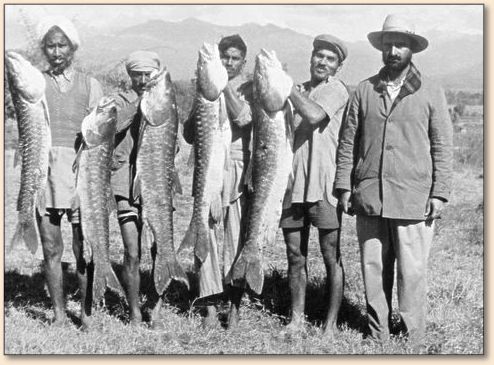
Some of the best fly-fishing was had from the Song, Ramganga
and the Saryu rivers of the once Uttar Pradesh region of
Northern India. There are also reports of good Mahseer been
caught on the river Beas, which runs though the state of
Himachal Pradesh. Fly-fishing for the Mahseer in the
Himalayan rivers was very common during the times of the
British Raj in India as it was a fine alternative to Salmon
fishing - something most expatriate anglers were used to back
at home. At that time they used large dark flies, mostly
black in colour, which looked like minnows, and grass hopper
like flies, and often rigged live grass hoppers onto the fly
hook and cast with the help of a fly line. Mr. Henry Sullivan
Thomas in his classic book The Rod In India has
mentioned many of his favourite patterns for the Mahseer. The
largest Mahseer caught in recent times caught, on fly, was by
Rowecliffe - a lady on a fly-fishing expedition lead by Mr.
Robert Howitt, who landed a 40 lbs specimen from the river Ramganga.
Reading the old literature and from the pre and the post
British Raj period, one generates a fair bit on interest
in the prospects for fly-fishing in the Himalayas,
especially with so many rivers and their tributaries to
choose from and such remarkable fly-fishing terrain. Mahseer,
have been caught by us from almost all of the main river
systems that drain the Northern Ranges and in their
productive tributaries - which include the Saryu, the
Mahakali, the Ramganga, the Beas, the Ganges, the Bhagirathi,
and a few others. There is a misconception that fly-fishing
for the Mahseer is done better in crystal clear spring fed
rivers rather than in glacial rivers - we have had equally
good fishing on both types of rivers.
Brigadier J. V. Pinto, author of Angling in Indian Rivers,
mentions the capture of several fish over the forty-fifty
pound range in the mid sixties from the Himalayan Rivers,
on spinning gear. This is one of the most significant books
of the post-British Raj period.
In 1977 Robert Howitt, Andrew Clark and Martin Clark set
off from England in search of the forgotten monsters,
which was called the Transworld Fishing Expedition. The
expedition was a good reminder to the western world of
the Mahseer, because soon after independence the sport
had slowed down and old records needed to be refreshed.
They covered all of India in a period of almost six months,
fishing the most significant rivers and had great luck
towards the end of the expedition with the capture of an
81 and a 92 pounder.
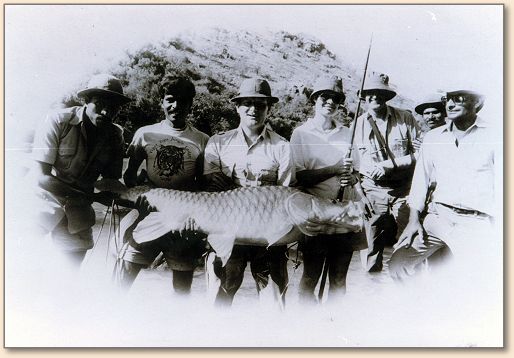
John Bailey along with Paul Boot shot the famous Casting
for Gold film in 1989, on the junction of Byas Ghat, on
the Ganges, where Paul caught a 51 lb. fish.
There have been as many large Mahseer in the most recent
past from the Himalayan Rivers, as anglers have ventured
into newer more untouched rivers and returned with great
stories. I had had a 55 lber on spinning from the Ganges
near Shivpuri in 2003; this record was evened the following
year by James Moorhouse again on a jointed lure, on the
junction of the Nayar and the Ganges.
Guidelines to Mahseer Game-fishing
The place to target when you are fishing for Mahseer in
the Himalayan Rivers is on the mouth a rapids, and in the
pool just before the mouth of rapid, for, you are most
likely to connect in this setting. Most large fish associate
themselves to structural elements - the presence of heavy
structural elements on the mouth of a rapids is indeed a
fine spot to look into. Though this makes your job on
hooking one far more exciting and tough - as these fish
will take no denial when they are hooked - one can only
imagine the adrenalin rush as these fish will utterly use
the torrent to run as they will take off at race horse speed.
I mostly use braided lines, and in fact it is firmly a
matter of personal selection, some of the finest Mahseer
fishermen prefer monofilament lines. I personally favour
braid - as I have become conscious that I am hooking 30%
more fish than when I am fishing monofilament lines. With
that said I feel that some of the best braids are not apt
for fishing in the presence of such heavy structural elements,
the situation I have explained above to the best place for
hooking a Himalayan Mahseer - hence I use a four to ten
foot monofilament leader in front of my braid, as I apprehend
that a monofilament can offer far more resistance to abrasions
against rocks and you also know when a monofilament starts
to wear out, quite unlike braided lines.
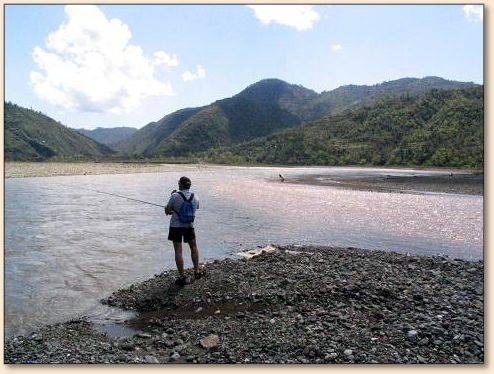
Fishing the drift, on a swift section of river, just above
the rapids is ideal. While fly-fishing for the Mahseer the
fly is cast into eddies of the current square of the angler
and stripped in jerks at a medium speed to keep pace with
the current. I have often had large Mahseer take on a dead
drift and that has most often happened to me while using
Muddler flies. An assortment of Muddlers is a must for the
fly box - these are ideal when dressed with lead eyes that
pop out like a dragon flies eyes, with the eyes being in
proportion to the body.
I mostly tie my own patterns, which are dressed with peacock
hurl, rooster neck hackle with bodies of chenille, tinsel
and dubbing fur.
In the pools, which one fishes during a warm mid-day, the
bottom bouncing technique is quite effective. Here the fly
is presented directly upstream and allowed to bottom walk
as it drifts along the bed, some 15 to 25 feet deep. This
is another very effective technique for when the fish are
in deeper waters.
Mahseer are mostly lost from frayed lines during a battle,
or off course, due to weak trebles or hooks, which are
often bent during a brawl.
If you are interested in fishing or fly-fishing for the
Mahseer and would like any information on this wild fishery
or would like to join us on our adventures then drop me a
line and I'll be happy to help.
Tight Lines. ~ Misty Dhillon, Chandigarh, India misty.dhillon@gmail.com
|

